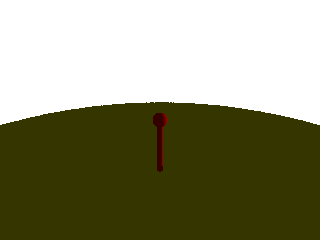|
Trefoil Knot
In knot theory, a branch of mathematics, the trefoil knot is the simplest example of a nontrivial knot (mathematics), knot. The trefoil can be obtained by joining the two loose ends of a common overhand knot, resulting in a knotted loop (topology), loop. As the simplest knot, the trefoil is fundamental to the study of mathematical knot theory. The trefoil knot is named after the three-leaf clover (or trefoil) plant. Descriptions The trefoil knot can be defined as the curve obtained from the following parametric equations: :\begin x &= \sin t + 2 \sin 2t \\ y &= \cos t - 2 \cos 2t \\ z &= -\sin 3t \end The (2,3)-torus knot is also a trefoil knot. The following parametric equations give a (2,3)-torus knot lying on torus (r-2)^2+z^2 = 1: :\begin x &= (2+\cos 3t) \cos 2t \\ y &= (2+\cos 3t )\sin 2t \\ z &= \sin 3t \end Any continuous deformation of the curve above is also considered a trefoil knot. Specifically, any curve Homotopy#Isotopy, isotopic to a trefoil knot is also co ... [...More Info...] [...Related Items...] OR: [Wikipedia] [Google] [Baidu] |
Knot Theory
In topology, knot theory is the study of knot (mathematics), mathematical knots. While inspired by knots which appear in daily life, such as those in shoelaces and rope, a mathematical knot differs in that the ends are joined so it cannot be undone, the simplest knot being a ring (or "unknot"). In mathematical language, a knot is an embedding of a circle in 3-dimensional Euclidean space, \mathbb^3. Two mathematical knots are equivalent if one can be transformed into the other via a deformation of \mathbb^3 upon itself (known as an ambient isotopy); these transformations correspond to manipulations of a knotted string that do not involve cutting it or passing it through itself. Knots can be described in various ways. Using different description methods, there may be more than one description of the same knot. For example, a common method of describing a knot is a planar diagram called a knot diagram, in which any knot can be drawn in many different ways. Therefore, a fundamental p ... [...More Info...] [...Related Items...] OR: [Wikipedia] [Google] [Baidu] |
Algebraic Geometry
Algebraic geometry is a branch of mathematics which uses abstract algebraic techniques, mainly from commutative algebra, to solve geometry, geometrical problems. Classically, it studies zero of a function, zeros of multivariate polynomials; the modern approach generalizes this in a few different aspects. The fundamental objects of study in algebraic geometry are algebraic variety, algebraic varieties, which are geometric manifestations of solution set, solutions of systems of polynomial equations. Examples of the most studied classes of algebraic varieties are line (geometry), lines, circles, parabolas, ellipses, hyperbolas, cubic curves like elliptic curves, and quartic curves like lemniscate of Bernoulli, lemniscates and Cassini ovals. These are plane algebraic curves. A point of the plane lies on an algebraic curve if its coordinates satisfy a given polynomial equation. Basic questions involve the study of points of special interest like singular point of a curve, singular p ... [...More Info...] [...Related Items...] OR: [Wikipedia] [Google] [Baidu] |
Tricolorability
In the mathematical field of knot theory, the tricolorability of a knot is the ability of a knot to be colored with three colors subject to certain rules. Tricolorability is an isotopy invariant, and hence can be used to distinguish between two different (non- isotopic) knots. In particular, since the unknot is not tricolorable, any tricolorable knot is necessarily nontrivial. Rules of tricolorability In these rules a strand in a knot diagram will be a piece of the string that goes from one undercrossing to the next. A knot is tricolorable if each strand of the knot diagram can be colored one of three colors, subject to the following rules:Weisstein, Eric W. (2010). ''CRC Concise Encyclopedia of Mathematics'', Second Edition, p.3045. . quoted at Accessed: May 5, 2013. :1. At least two colors must be used, and :2. At each crossing, the three incident strands are either all the same color or all different colors. Some references state instead that all three colors must be used.Gi ... [...More Info...] [...Related Items...] OR: [Wikipedia] [Google] [Baidu] |
Knot Invariant
In the mathematical field of knot theory, a knot invariant is a quantity (in a broad sense) defined for each knot which is the same for equivalent knots. The equivalence is often given by ambient isotopy but can be given by homeomorphism. Some invariants are indeed numbers (algebraic), but invariants can range from the simple, such as a yes/no answer, to those as complex as a homology theory (for example, "a ''knot invariant'' is a rule that assigns to any knot a quantity such that if and are equivalent then ."). Research on invariants is not only motivated by the basic problem of distinguishing one knot from another but also to understand fundamental properties of knots and their relations to other branches of mathematics. Knot invariants are thus used in knot classification,Purcell, Jessica (2020). ''Hyperbolic Knot Theory'', p.7. American Mathematical Society. "A ''knot invariant'' is a function from the set of knots to some other set whose value depends only on the equiva ... [...More Info...] [...Related Items...] OR: [Wikipedia] [Google] [Baidu] |
Reidemeister Move
In the mathematical area of knot theory, a Reidemeister move is any of three local moves on a link diagram. and, independently, , demonstrated that two knot diagrams belonging to the same knot, up to planar isotopy, can be related by a sequence of the three Reidemeister moves. Each move operates on a small region of the diagram and is one of three types: No other part of the diagram is involved in the picture of a move, and a planar isotopy may distort the picture. The numbering for the types of moves corresponds to how many strands are involved, e.g. a type II move operates on two strands of the diagram. One important context in which the Reidemeister moves appear is in defining knot invariants. By demonstrating a property of a knot diagram which is not changed when we apply any of the Reidemeister moves, an invariant is defined. Many important invariants can be defined in this way, including the Jones polynomial. The type I move is the only move that affects the writh ... [...More Info...] [...Related Items...] OR: [Wikipedia] [Google] [Baidu] |
Unknot
In the knot theory, mathematical theory of knots, the unknot, not knot, or trivial knot, is the least knotted of all knots. Intuitively, the unknot is a closed loop of rope without a Knot (mathematics), knot tied into it, unknotted. To a knot theorist, an unknot is any embedding, embedded Topological sphere, topological circle in the 3-sphere that is ambient isotopy, ambient isotopic (that is, deformable) to a geometrically round circle, the standard unknot. The unknot is the only knot that is the boundary of an embedded disk (mathematics), disk, which gives the characterization that only unknots have Seifert surface, Seifert genus 0. Similarly, the unknot is the identity element with respect to the knot sum operation. Unknotting problem Deciding if a particular knot is the unknot was a major driving force behind knot invariants, since it was thought this approach would possibly give an efficient algorithm to unknotting problem, recognize the unknot from some presentation ... [...More Info...] [...Related Items...] OR: [Wikipedia] [Google] [Baidu] |
Tricoloring
In the mathematics, mathematical field of knot theory, the tricolorability of a knot (mathematics), knot is the ability of a knot to be colored with three colors subject to certain rules. Tricolorability is an Knot invariant, isotopy invariant, and hence can be used to distinguish between two different (non-Regular isotopy, isotopic) knots. In particular, since the unknot is not tricolorable, any tricolorable knot is necessarily nontrivial. Rules of tricolorability In these rules a strand in a knot diagram will be a piece of the string that goes from one undercrossing to the next. A knot is tricolorable if each strand of the knot diagram can be colored one of three colors, subject to the following rules:Weisstein, Eric W. (2010). ''CRC Concise Encyclopedia of Mathematics'', Second Edition, p.3045. . quoted at Accessed: May 5, 2013. :1. At least two colors must be used, and :2. At each crossing, the three incident strands are either all the same color or all different colors. Som ... [...More Info...] [...Related Items...] OR: [Wikipedia] [Google] [Baidu] |
Counterclockwise
Two-dimensional rotation can occur in two possible directions or senses of rotation. Clockwise motion (abbreviated CW) proceeds in the same direction as a clock's hands relative to the observer: from the top to the right, then down and then to the left, and back up to the top. The opposite sense of rotation or revolution is (in Commonwealth English) anticlockwise (ACW) or (in North American English) counterclockwise (CCW). Three-dimensional rotation can have similarly defined senses when considering the corresponding angular velocity vector. Terminology Before clocks were commonplace, the terms " sunwise" and "deasil", "deiseil" and even "deocil" from the Scottish Gaelic language and from the same root as the Latin "dexter" ("right") were used for clockwise. " Widdershins" or "withershins" (from Middle Low German "weddersinnes", "opposite course") was used for counterclockwise. The terms clockwise and counterclockwise can only be applied to a rotational motion once a side ... [...More Info...] [...Related Items...] OR: [Wikipedia] [Google] [Baidu] |
Ambient Isotopy
In the mathematical subject of topology, an ambient isotopy, also called an ''h-isotopy'', is a kind of continuous distortion of an ambient space, for example a manifold, taking a submanifold to another submanifold. For example in knot theory, one considers two knots the same if one can distort one knot into the other without breaking it. Such a distortion is an example of an ambient isotopy. More precisely, let N and M be manifolds and g and h be embeddings of N in M. A continuous map :F:M \times ,1\rightarrow M is defined to be an ambient isotopy taking g to h if F_0 is the identity map, each map F_t is a homeomorphism from M to itself, and F_1 \circ g = h. This implies that the orientation must be preserved by ambient isotopies. For example, two knots that are mirror images of each other are, in general, not equivalent. See also * Isotopy * Regular homotopy *Regular isotopy References *M. A. Armstrong, ''Basic Topology'', Springer-Verlag Springer Science+Business M ... [...More Info...] [...Related Items...] OR: [Wikipedia] [Google] [Baidu] |
Chirality (mathematics)
In geometry, a figure is chiral (and said to have chirality) if it is not identical to its mirror image, or, more precisely, if it cannot be mapped to its mirror image by Rotation (mathematics), rotations and Translation (geometry), translations alone. An object that is not chiral is said to be ''achiral''. A chiral object and its mirror image are said to be enantiomorphs. The word ''chirality'' is derived from the Greek (cheir), the hand, the most familiar chiral object; the word ''enantiomorph'' stems from the Greek (enantios) 'opposite' + (morphe) 'form'. Examples Some chiral three-dimensional objects, such as the helix, can be assigned a right or left handedness, according to the right-hand rule. Many other familiar objects exhibit the same chiral symmetry of the human body, such as gloves and shoes. Right shoes differ from left shoes only by being mirror images of each other. In contrast thin gloves may not be considered chiral if you can wear them wiktionary:inside ou ... [...More Info...] [...Related Items...] OR: [Wikipedia] [Google] [Baidu] |
Cuspidal Cubic
In mathematics, a cuspidal cubic or semicubical parabola is an algebraic plane curve that has an implicit equation of the form : y^2 - a^2 x^3 = 0 (with ) in some Cartesian coordinate system. Solving for leads to the ''explicit form'' : y = \pm a x^, which imply that every real point satisfies . The exponent explains the term ''semicubical parabola''. (A parabola can be described by the equation .) Solving the implicit equation for yields a second ''explicit form'' :x = \left(\frac\right)^. The parametric equation : \quad x = t^2, \quad y = a t^3 can also be deduced from the implicit equation by putting t = \frac. . The semicubical parabolas have a cuspidal singularity; hence the name of ''cuspidal cubic''. The arc length of the curve was calculated by the English mathematician William Neile and published in 1657 (see section History). Properties of semicubical parabolas Similarity Any semicubical parabola (t^2,at^3) is similar to the ''semicubical unit parabola'' ... [...More Info...] [...Related Items...] OR: [Wikipedia] [Google] [Baidu] |




